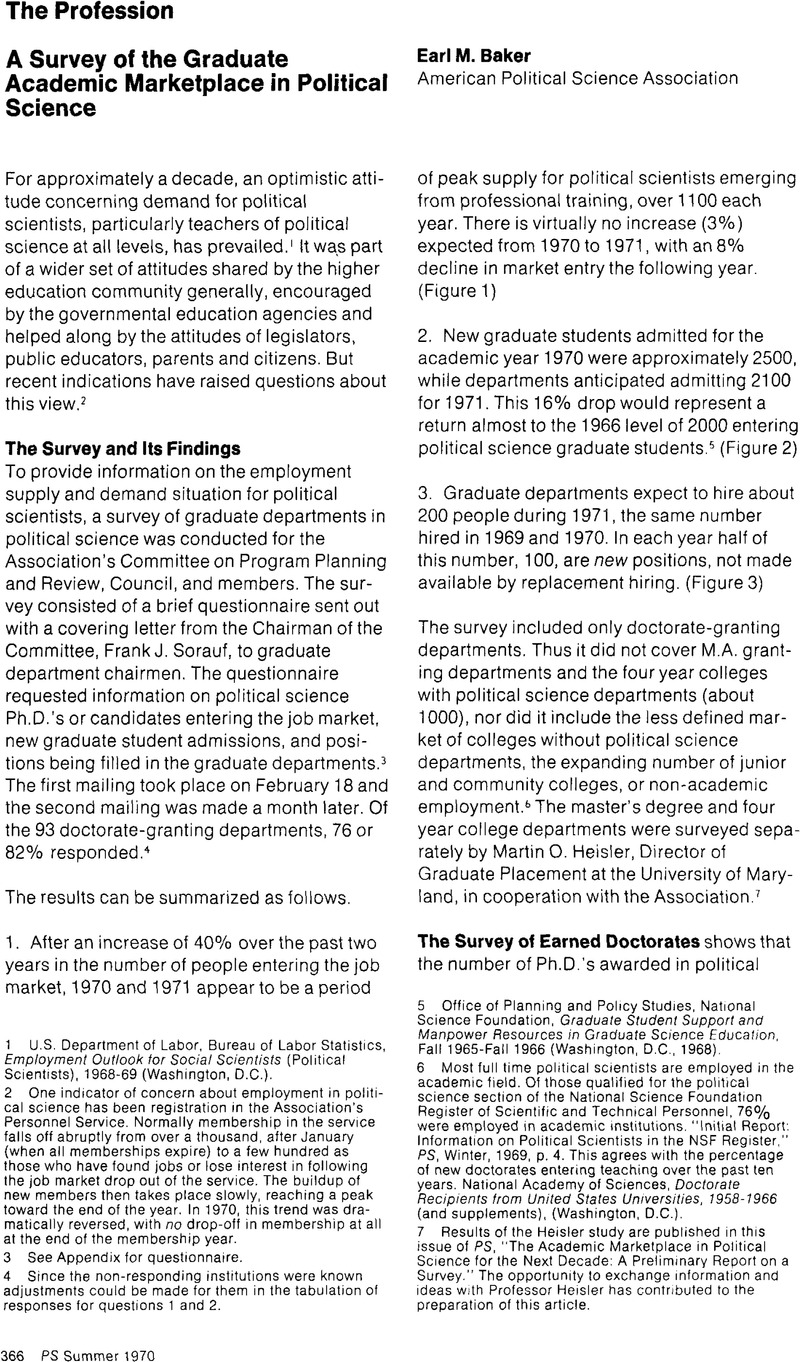Article contents
A Survey of the Graduate Academic Marketplace in Political Science
Published online by Cambridge University Press: 28 November 2022
Abstract

- Type
- News
- Information
- Copyright
- Copyright © The American Political Science Association 1970
References
1 U.S. Department of Labor, Bureau of Labor Statistics, Employment Outlook tor Social Scientists (Political Scientists), 1968–1969 (Washington, D.C.).Google Scholar
2 One indicator of concern about employment in political science has been registration in the Association's Personnel Service. Normally membership in the service falls off abruptly from over a thousand, after January (when all memberships expire) to a few hundred as those who have found jobs or lose interest in following the job market drop out of the service. The buildup of new members then takes place slowly, reaching a peak toward the end of the year. In 1970, this trend was dramatically reversed, with no drop-off in membership at all at the end of the membership year.
3 See Appendix for questionnaire.
4 Since the non-responding institutions were known adjustments could be made for them in the tabulation of responses for questions 1 and 2.
5 Office of Planning and Policy Studies, National Science Foundation, Graduate Student Support and Manpower Resources in Graduate Science Education, Fall 1965-Fall 1966 (Washington, D.C., 1968).
6 Most full time political scientists are employed in the academic field. Of those qualified for the political science section of the National Science Foundation Register of Scientific and Technical Personnel, 76% were employed in academic institutions. “Initial Report: Information on Political Scientists in the NSF Register,” PS, Winter, 1969, p. 4. This agrees with the percentage of new doctorates entering teaching over the past ten years. National Academy of Sciences, Doctorate Recipients trom United States Universities, 1958–1966 (and supplements), (Washington, D.C.).Google Scholar
7 Results of the Heisler study are published in this issue of PS, “The Academic Marketplace in Political Science for the Next Decade: A Preliminary Report on a Survey.” The opportunity to exchange information and ideas with Professor Heisler has contributed to the preparation of this article.
8 National Academy of Sciences, op. cit., 1969 Supplement.
9 Cartter, Allan M., An Assessment of Quality in Graduate Education (Washington, D.C.: American Council on Education, 1966), p. 40.Google Scholar
10 American Council on Education, A Guide to Graduate Study (Washington, D.C.: 3rd Edition, 1965; 4th Edition, 1969).Google Scholar
11 The Heisler mean figures would suggest about 60 new openings peryear. If the maximum figures are used, 90, it coincides with the APSA survey estimate of 100.
12 Falk, Charles E., “Science and Engineering Doctorate Supply and Utilization, 1968–80,” Mosaic, Spring, 1970, pp. 14–19.Google Scholar
13 Allan M. Cartter, National Conference on Higher Education, March 1970.
14 Cartter, Allan M. and Farrell, Robert L., “Academic Labor Market Projections and the Draft,” in Joint Economic Committee, The Economics ol Higher Education (Washington, D.C., 1969), pp. 357–374.Google Scholar
15 Eulau, Heinz and March, James G. (eds.), Political Science (Behavioral and Social Sciences Survey) (Englewood Cliffs: Prentice-Hall, 1969), p. 70.Google Scholar
16 Science Magazine, “Employment Status of Recent Recipients of Doctorate,” May 22, 1970, p. 932.
17 Related by Professor Howard Penniman, Georgetown University.
18 Eulau, Heinz, “The Behavioral Movement in Political Science: A Personal Document,” in Micro-Macro Political Analysis: Accents of Inquiry (Chicago: Aldine, 1969), p. 375.Google Scholar
19 Rosenhaupt, Hans, “Are There Too Many Doctors in the House?”, Woodrow Wilson Fellowship Newsletter, May, 1970, p. 1, 8.Google Scholar
- 4
- Cited by




